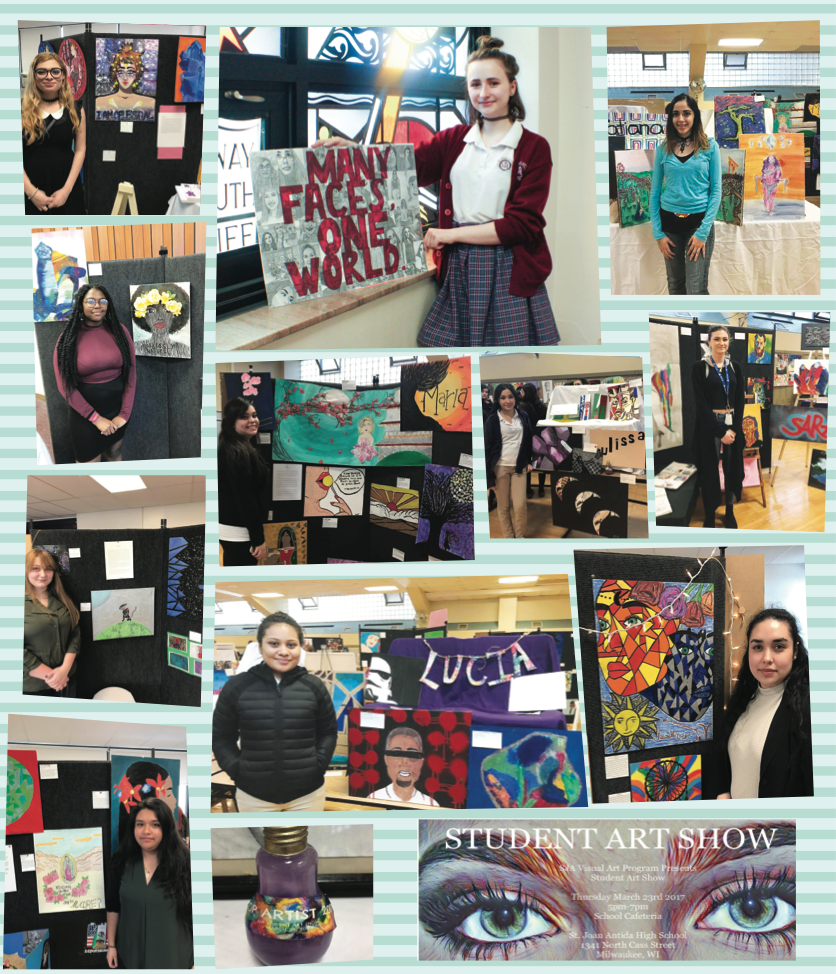It should have been a disaster — a ceramics project that exploded in the kiln, leaving one hardworking art student with a few shards of broken pottery instead of a completed piece fit for her portfolio.
But instead, it was a life lesson. “I kind of just rolled with it, and I made it into a piece that was way better than the original that I had,” said Sarah Kopacz, a senior at St. Joan Antida High School and creator of the exploding dish. “Happy mistakes, I guess.”
Those kinds of “happy mistakes” are common in the art classes of Carolyn “CC” Braunreiter, Kopacz’s teacher and SJA Art Department Chair. “In my art room, being comfortable to fail and being able to learn from those failures and mistakes is really important,” she said.
That’s because for Braunreiter and her students, it isn’t really about the finished product — it’s about the hundreds of teaching moments waiting to be discovered in the artistic process.
SJA is a school that prides itself, in particular, on the strength of its STEM curriculum — subjects relating to of science, technology, engineering and math. That’s reflective of a national trend toward more emphasis on engineering in K-12 education, which in general is resulting in more emphasis on problem-solving, evaluation of hypothesis and attention to process of design.

With the ART, students at St. Joan Antida High School are creating STEAM out of the high school STEM program with their annual art show.
These are all key components of any worthwhile art education, too, said Braunreiter. In other words, with the addition of ART – STEAM is the new STEM.
“The most important part of teaching art to them is to teach them how to show process. We’re showing them how to be critical thinkers, how to be problem-solvers,” said Braunreiter. “Don’t be afraid to fail. Let’s fail in this comfortable setting and learn what works and what doesn’t.”
She knows that most of her students will not become artists; many will never even take another art class once they graduate from SJA. But that’s not really the point. She encourages all students to take at least three years of art classes despite their academic track, seeing it as a significant complement to every subject from mathematics to engineering and beyond.
A career in art isn’t in Kopacz’s future — she hopes to go into environmental science, with an emphasis in public policy. But she says the lessons she’s learned in Braunreiter’s class have impacted every aspect of her academic and personal life.
“I think the spontaneous kinds of things that happen in art, teach you how to be a productive person in real life,” she said, referring to that broken dish — which she actually ended up reassembling and incorporating into her senior art exhibit.
That student-curated exam is a crucial moment of assessment for SJA seniors enrolled in the International Baccalaureate (IB) Diploma Programme, one of two IB programs offered by the school for the last two years.
The IB program emphasizes a theory of well-rounded education, of which proficiency in the visual arts is integral. By the time they graduate, IB students at SJA will have a portfolio of 18 to 30 completed pieces representing a wide range of artistic disciplines. For their senior exhibit, they must select nine pieces for display, curate the exhibit themselves with no help from Braunreiter, write a curatorial rationale to explain why they’ve placed their pieces the way they have, and be on-hand to discuss their work with the public.
Braunreiter believes that, even if her students do not pursue art as a career path, the skills they learn in her classroom will make them more well-rounded individuals and more versatile employees. Juniors and seniors taking her IB Art I and II are tasked with creating all their own project ideas. She teaches them technical skills and develops units and topics of study, but all project proposals originate with the students.
In contrast, Kopacz said, in previous experiences with art instruction, she felt constricted by overly rigid rules and syllabi.
“It was more, do this and if you don’t do it like this then you’re wrong,” she said. “But whenever you do stuff here, you have so much creative control over what you’re doing. You actually feel as if art is someplace you can go to that you can just be yourself.”
Fellow senior Guadalupe Gutierrez-Tinoco said that four years of art education at SJA helped her to “be free and express my emotions in the way that I want to.
“I have discovered a talent I did not know I had,” she said, adding that art has challenged her to become “a risk-taker.” She plans to pursue a career in law after attending Ripon College.
“When I started art at SJA, I didn’t want to do it (art) because I thought I didn’t know how to draw or paint,” she said.
That’s a common concern among prospective students, said Braunreiter. She estimates that about half of her incoming freshmen have been exposed to middle school art classes. The other half have either never seen an art class or haven’t experienced one since elementary school or kindergarten.
“When prospective students come in for walk-throughs, I’ll ask them, do you like art? ‘No, I hate art.’ Do you like to make things?” said Braunreiter. “They have this bar up, like I’m not good at drawing so I’m not good at art. That’s not going to work in here.”
Kopacz said that the biggest lesson she’s learned in art is how to fail.
“In the traditional sense, failing — I’ve done that a lot in here,” she said. “But it doesn’t feel like failing when you’re in here. It feels more as if you’re learning about something.”
